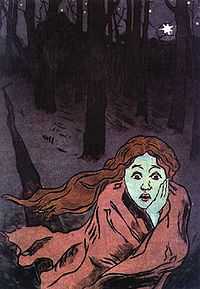Motivation and emotion/Book/2011/Fear
< Motivation and emotion < Book < 2011
  F E A R: Understanding and managing the ever present phantom of emotion |
|
Introduction
Our everyday existence is surrounded by problems, obstacles and challenges. Emotions are our natural response that help us to deal with them [2]. Fear is an emotion we have all experienced. We experience fear in response to an external event or thought that we perceive as a threat. We might feel our heart beating faster or harder than usual, breathing differently, perhaps some shivering or sweating, or we might feel completely frozen for a split second in which we simply don’t think and we feel totally paralysed and vulnerable. These are just some of the physiological symptoms that accompany the experience of fear. It is definitely an unpleasant emotion for most of us. People can fear almost anything, the list is endless; some of these fears can be considered rational, other not so much. Below is a list of common fears, ask yourself, how many have you experienced?
- Fear of death.
- Fear of heights.
- Fear of losing our jobs.
- Fear of rejection.
- Fear of failure.
- Fear of spiders.
- Fear of terrorism.
- Fear of being separated from people we love.
- Fear of losing control in various situations.
- Fear of flying.
- Fear of germs.
- Fear of illness.
- Fear of speaking in public.
Have you experienced more than one? If so, you are a common human. If you haven’t experienced at least one of them, you are certainly extraordinary and defy most theories presented on this chapter.
But, why do we fear? Many would argue fear is a negative emotion that impedes our normal functioning, so how is it helpful in our everyday lives? And ultimately, how can we exert some degree of control over it? The aim of this chapter is to explore answers to these and other questions by examining relevant and contemporary theories and research.
Focus Questions
|
Definition(s)
The experience of fear is usually classified under two categories: Minor or ordinary fears and phobias. Minor fears are experienced as an unreasonable amount of anxiety and other symptoms to a specific stimulus that is perceived as a threat. When this fear interferes and impedes daily normal functioning, it becomes a phobia. [3].
Content: Theoretical Background and Research
The four components of Emotion
Emotions are experienced in four different ways [4]. These are the four different components or dimensions of emotion.
- Subjective: this component includes how we feel and perceive the emotion and our verbal interpretation of it.
- Physiological or Biological: involves the way our body reacts physiologically to the situation.
- Functional: the functional dimension of the emotion involves its purpose.
- Social expression: this is how we publicly express the emotion. How we communicate it to others and how it influences social interaction.
Let’s take a moment and analyse fear under these four components. Subjectively, we may experience it as a shock followed by anxiety and perhaps a mild body paralysis. Physiologically, our hear rate might increase, breathing might become more difficult and shivers might travel around our bodies. The functional purpose of fear is to protect us from a threat. Finally, we might express it as running away and asking out for help.
Fear as a Basic or Primary Emotion
Basic emotions are those which share certain universal characteristics [5]. A basic emotion is part of the innate nature of a human being. In other words, it is not acquired through experience or socialisation. This type of emotions is also expressed in a unique and universal way. That is to say, every individual expresses the emotion in a particular way which is distinct from other emotions. Basic emotions are accompanied by an expectable physiological response. And finally, they arise from the same situation and circumstances for every person.
Fear shares all of these characteristics. We can see from babies to adults of the third age experiencing fear under similar circumstances and displaying similar facial expressions.
Terror Management theory
Terror Management Theory (TMT) is based on the writings of Ernest Becker [6] Its basic premise is that humans have an instinct for self-preservation as any other animal but they acknowledge that their lives will end and can be in an unexpected and sudden way. This awareness of death leads a person to fear the end of his existence. Researchers recognize two types of defenses people have to reduce the anxiety related to death awareness [7].
- Distal: Are triggered when thoughts of death are no longer part of the focus of attention but are available in the preconscious mind. The nature of these defences is symbolic in the sense that they establish a sense of personal value in a continuing and significant world. Symbolic defences encompass cultural worldviews and self-esteem endeavours.
- Proximal: Are triggered when thoughts of death enter conscious awareness. They typically intend to suppress or make such thoughts less disturbing by denying mortality or focusing on thoughts of longevity.
How can cultural worldviews alleviate death anxiety? They can describe the world in various ways in which death is less threatening. They can even define chances of transcending death either symbolically or literally [8]. Additionally, they can describe the world as safe, stable and non-chaotic, which gives the individual a sense that they are in control of their mortality. [9]. Typical worldviews that lessen death anxiety include religions that proclaim any sort of life after corporeal death. Also, cultural views that give importance to things created by the individual which persist after his or her corporeal death like art works, or their offspring.
Self-esteem can also play a role in reducing death anxiety. Both cultural worldview and self-esteem can change self and world interpretation to one less threatening to life. Self-esteem can create a feeling of uniqueness in which one is different from the rest of society and less or not vulnerable to death at all. Also, self-esteem may create the belief that one’s consequences of their actions, or contributions to the world may endure after corporeal death.
|
Experiments on Terror Management Theory: Recent studies on TMT have found evidence supporting its premises. It was found that when death enters awareness, people with an internal locus of control decrease intentions to engage in risky behaviour[10].Also people started preferring using sunscreen with higher SPF [11]. Additionally, people showed more intensions to start exercising when they had a reminder of death [12]. |
See also
Phobias and Fears Symptoms, treatments and self-help
References
- ↑ Herbert, F. (1965) Dune chronicles: Book 1. Ace Books, NY..
- ↑ Ekman, P. (1992) An argument for basic emotions. Cognitions and Emotions, 6, 169-200.
- ↑ Triscari, M. T., Faraci, P., D’Angelo, V., Urso, V. & Catalisiano, D. (2011). Two treatments of fear compared cognitive behavioral therapy combined with systematic desensitization or eye movement desensitization and reprocessing. Aviation Psychology and Applied Human Factors, 1, 9-14
- ↑ Izard, C. E. (1993). Four systems for emotional activation: Cognitive and noncognitive development. Psychological Review, 100, 68-90.
- ↑ Ekman, P. & Davidson, R. J. (Eds.). (1994).
- ↑ Becker, E. (1973). The denial of death. New York: Free Press.
- ↑ Pyszczynski, T., Greenberg, J., & Solomon, S. (1999). A dual-process model of defense against conscious and unconscious death-related thoughts: An extension of terror management theory. Psychological Review, 106, 835–845.
- ↑ Lifton, R. J. (1979). The broken connection. New York: Simon & Schuster
- ↑ Bassett, J. F. (2007). Psychological defences against death anxiety: Integrating terror management theory and Firestone’s separation theory. Death studies, 31, 727-750.
- ↑ Miller, R. L. & Mulligan, R. D. (2002). Terror management: The effects of mortality salience and locus of control on risk-taking behaviours. Personality and Individual Differences, 33, 1203–1214.
- ↑ Routledge, C., Arndt, J., & Goldenberg, J. L. (2004) A time to tan: Proximal and distal effects of mortality salience on sun exposure intentions. Personality and Social Psychology Bulletin, 30, 1347–1358.
- ↑ Arndt, J., Schimel, J., & Goldenberg, J. L. (2003). Death can be good for your health: Fitness intentions as a proximal and distal defense against mortality salience. Journal of Applied Social Psychology, 33, 1726–1746.
